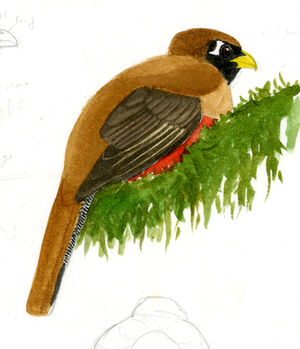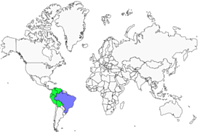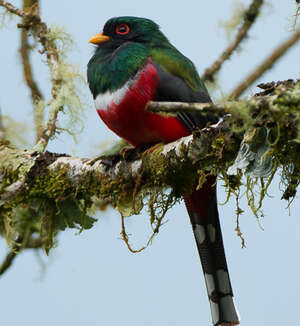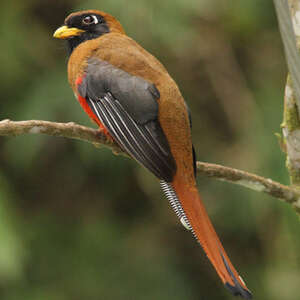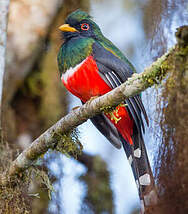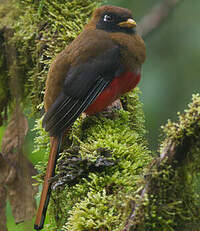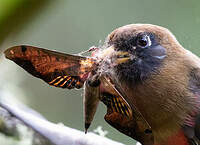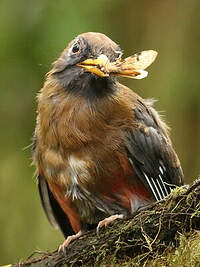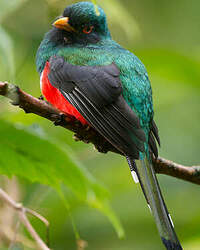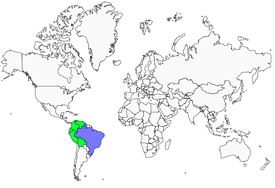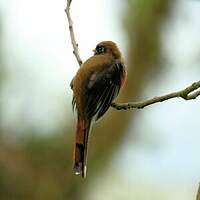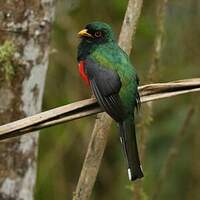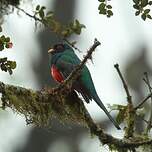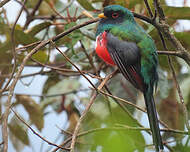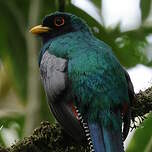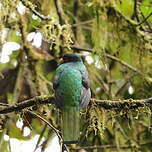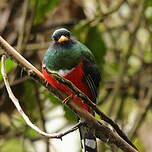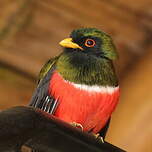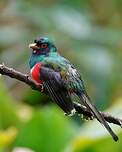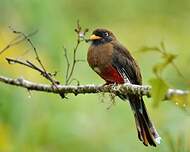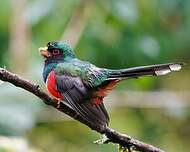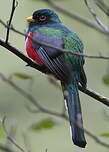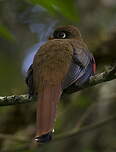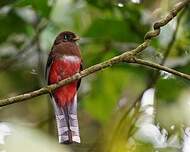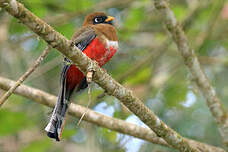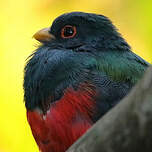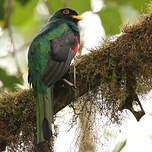Masked Trogon
Trogon personatus - Trogon masqué
Identification
Latin for masked or deceptive, the Masked Trogon deceives its audience, notably with the similar-looking Rosalba Trogon. The Masked Trogon measures 25 cm and sexual dimorphism is quite pronounced. Mr. Personatus, after whom the species is named, has black parrot and throat areas, contrasting with a strong yellow beak and an orange-red orbital circle; the iris is dark brown, the crown, nape, and mantle are emerald green with beautiful bronze highlights, the back and scapulars reverse the tones and become bronze with blue-green highlights. The breast keeps this green-bronze shade and is underscored by a white crescent-moon shape, marking the separation with a bright red belly. The scapulars are green, the anthracite coverts are vermiculated with very fine horizontal white lines, unlike that of the Collared Trogon which shows wider and more visible vermiculations; the remiges are practically black and sharply lined with white. The three pairs of lower rectrices are striped with horizontal white threads, each pair ending with a wide white mark, the end of the tail being barred with a black mark. The upper rectrices are coppery with golden hues and outlined in black at their tips. Mrs. Masked Trogon keeps her black parrot and throat areas, the beak being yellow; the whitish orbital circle is faintly marked; however the bird has applied makeup to the back part of its eye with a small white-plumed arc which is characteristic of the female Masked Trogon, many other species like the Rosalba Trogon presenting two half-circles in front and back of the eye. The crown, nape, mantle, and back are of a luminous brown and sometimes golden in the light; the same wider white mark separates the chest from the red belly with a slightly rosy tone.The scapulars are the same brown as the mantle and coverts always vermiculated anthracite and white but with a general shade slightly hazel, the remiges black, always tinged brown, keep the white emarginations. The lower rectrices appear rather black while they are actually striped with very fine white lines, each of the three pairs of rectrices ending in a large rectangular white mark, the tip of the tail barred with a black line. The upper rectrices are brown-hazel with copper reflections and end in a very clear black bar. All feminine allurement, the bird can let out its lower rectrices on either side of the upper rectrices to show stripes of black and white tips. The young adopt the dress of their mother, but the light brown breast turns to chamois on the belly, the coverts are more brown than black and begin to be vermiculated, the tail on the lower rectrices is almost black and only shows the horizontal white lines in places.
Subspecific information 9 subspecies
- Trogon personatus personatus (e Colombia and w Venezuela to e Peru)
- Trogon personatus sanctaemartae (Santa Marta Mts.. ne Colombia.)
- Trogon personatus ptaritepui (tepuis of s Venezuela)
- Trogon personatus duidae (Mt. Duida. s Venezuela.)
- Trogon personatus roraimae (Mt. Roraima and nearby tepuis. se Venezuela, w Guyana.)
- Trogon personatus assimilis (w Colombia, w Ecuador and nw Peru)
- Trogon personatus temperatus (c Colombia and Ecuador)
- Trogon personatus heliothrix (temperate Peru)
- Trogon personatus submontanus (se Peru and Bolivia)
Foreign names
- Trogon masqué,
- Trogón enmascarado,
- surucuá-mascarado,
- Maskentrogon,
- Maskertrogon,
- Trogone mascherato,
- svartmaskad trogon,
- Masketrogon,
- trogón maskový,
- trogon škraboškový,
- Masketrogon,
- naamiotrogoni,
- trogon emmascarat,
- trogon maskowy,
- Масковый трогон,
- カオグロキヌバネドリ,
- 美洲咬鹃,
- 黑臉美洲咬鵑,
Voice song and cries
Habitat
The Masked Trogon may be more mountain dwelling than the Mountain Trogon! It can usually be seen between 700 and 3,600m, sometimes even higher. It prefers wet and misty forests, but can also be found in secondary forests and more open forested areas. One constant of its locations is the presence of epiphytic plants at a height of 20 to 25m, or more, where it can find seeds, fruits or berries.
Behaviour character trait
Dietfeeding habits
The Masked Trogon is a frugivore, enjoying fruits from Clusiaceae such as mangosteen trees or Mammea americana, also known as the Caribbean Avocado (which has nothing to do with our avocado!). Insectivorous, it catches a wide variety of flying insects: butterflies, beetles, caterpillars and larvae make up its diet. When it comes to feeding its young, it will likely become mainly insectivorous.
Reproduction nesting
Geographic range
One of the trogons with the highest number of subspecies: 9! Ssp personatus personatus which gives its name to the species (west of Venezuela, the farthest west of Colombia and the Pacific shores of Ecuador) - ssp sanctaemartae, darker in its coverings than personatus, with more whitish vermiculations in the male and cream in the female (northwest Colombia, in the Santa Marta massif) - ssp temperatus, which some hope to promote to the rank of species, the male having a brighter green coloring with blue reflections on the cap, mantle and back, the beak shorter, the lower rectrices showing almost no white lines, appearing black with only three large white marks at the extremity of the three pairs of rectrices, the female of a very strong brown dominant, brown-tawny on the cap, forehead and throat, very dark brown-chestnut on the back, brown coverings with marked white vermiculations, lower rectrices with little visible white lines, upper rectrices of a very strong brown-tawny, tropical wet zone (center and east of the central and Ecuadorian cordillera) - ssp heliothrix, similar to personatus, small beak, the male having less marked vermiculations and the coverings blackish-gray appearing more unbroken, the upper rectrices having a blue-green shade, the horizontal white lines of the lower rectrices much more marked, the three white marks very large, the female pâler on the breast, the coverings rather gray and the vermiculations less marked than temperatus, the lower rectrices more white than black (very localized on the eastern flanks of the cordillera in Peru, region of Junin) - ssp submontanus, very close to temperatus, larger beak, the male showing upper rectrices of a blue shade, the lower rectrices very black, the white lines hardly visible, the female having the coverings grayer than temperatus, the vermiculations more diffuse, coloring general enough toned down (on the eastern flanks of the Peruvian cordillera, region of Puno near the Bolivian border, also in the south of Bolivia, region of Chuquisaca) - ssp assimilis, very close to personatus, beak larger, the male having the upper rectrices gold-green, the white vermiculations on the coverings very fine and the latter appearing anthracite, the horizontal white lines of the lower rectrices extremely fine, the female resembling much the female personatus, the vermiculations barely visible on the coverings (west of the western cordillera in Colombia, the closest to the Pacific, up to the western flanks of the Andes in Ecuador and northwest Peru, region of Piura) - ssp duidae, rather small, the male having the mantle and back copperish, the upper rectrices of a tawny-coppery, the lower rectrices rather marbled white than classically lined, the female resembling the female personatus but is not or scarcely observed (confined to the center and south of Venezuela, localized very dispersedly in the mountainous regions of Brazilian Amazonia, northwest of Bolivia) - ssp roraimae immediately recognizable, the cap, nape and back more bronze than green, shoulder-scapulars almost golden-green, the upper rectrices brown-chestnut of bronze hues, the lower rectrices having rather wide white stripes, the female looking like personatus but showing the same thick white stripes as the male (the distribution more erratic: in the mountains of the center and south of Bolivia, in Brazilian Amazonia, of course in the state of Roraima, also in the farthest west of Guyana) - ssp ptaritepui, similar to roraimae, no clearly catalogued observation (confined to the southeast of Venezuela in the state of Bolivar, taking its name from the Ptari-tepui mountain which reaches a summit of 2 400 m).
One of the trogons with the highest number of subspecies: 9! The Masked Trogon's (Trogon masqué) ssp personatus personatus gives its name to the species (west of Venezuela, the farthest west of Colombia and the Pacific shores of Ecuador) - ssp sanctaemartae, darker in its coverings than personatus, with more whitish vermiculations in the male and cream in the female (northwest Colombia, in the Santa Marta massif) - ssp temperatus, which some hope to promote to the rank of species, the male having a brighter green coloring with blue reflections on the cap, mantle and back, the beak shorter, the lower rectrices showing almost no white lines, appearing black with only three large white marks at the extremity of the three pairs of rectrices, the female of a very strong brown dominant, brown-tawny on the cap, forehead and throat, very dark brown-chestnut on the back, brown coverings with marked white vermiculations, lower rectrices with little visible white lines, upper rectrices of a very strong brown-tawny, tropical wet zone (center and east of the central and Ecuadorian cordillera) - ssp heliothrix, similar to personatus, small beak, the male having less marked vermiculations and the coverings blackish-gray appearing more unbroken, the upper rectrices having a blue-green shade, the horizontal white lines of the lower rectrices much more marked, the three white marks very large, the female pâler on the breast, the coverings rather gray and the vermiculations less marked than temperatus, the lower rectrices more white than black (very localized on the eastern flanks of the cordillera in Peru, region of Junin) - ssp submontanus, very close to temperatus, larger beak, the male showing upper rectrices of a blue shade, the lower rectrices very black, the white lines hardly visible, the female having the coverings grayer than temperatus, the vermiculations more diffuse, coloring general enough toned down (on the eastern flanks of the Peruvian cordillera, region of Puno near the Bolivian border, also in the south of Bolivia, region of Chuquisaca) - ssp assimilis, very close to personatus, beak larger, the male having the upper rectrices gold-green, the white vermiculations on the coverings very fine and the latter appearing anthracite, the horizontal white lines of the lower rectrices extremely fine, the female resembling much the female personatus, the vermiculations barely visible on the coverings (west of the western cordillera in Colombia, the closest to the Pacific, up to the western flanks of the Andes in Ecuador and northwest Peru, region of Piura) - ssp duidae, rather small, the male having the mantle and back copperish, the upper rectrices of a tawny-coppery, the lower rectrices rather marbled white than classically lined, the female resembling the female personatus but is not or scarcely observed (confined to the center and south of Venezuela, localized very dispersedly in the mountainous regions of Brazilian Amazonia, northwest of Bolivia) - ssp roraimae immediately recognizable, the cap, nape and back more bronze than green, shoulder-scapulars almost golden-green, the upper rectrices brown-chestnut of bronze hues, the lower rectrices having rather wide white stripes, the female looking like personatus but showing the same thick white stripes as the male (the distribution more erratic: in the mountains of the center and south of Bolivia, in Brazilian Amazonia, of course in the state of Roraima, also in the farthest west of Guyana) - ssp ptaritepui, similar to roraimae, no clearly catalogued observation (confined to the southeast of Venezuela in the state of Bolivar, taking its name from the Ptari-tepui mountain which reaches a summit of 2 400 m).
Threats - protection
IUCN conservation status
concern
in the Wild
threatened
evaluated
The Masked Trogon (LC) isn't in danger currently, since its large distribution area is spread out in often inaccessible areas that protect it. Unfortunately, farmers have seen to hunt this magnificent trogon for its feathers in the national park of Las Orquideas, Colombia. The old adage, to live long, live hidden can be applied to it! A few subspecies like roraimae or ptaritepui are very little known and observed, and this part of mystery makes it even more attractive.
Sources of information
- IOC World Bird List (v14.1), Gill, F and D Donsker (Eds). 2024-04-18.
- A Natural history of the Trogonidae, Joseph M.Forshaw Albert Earl Gilbert
- Vol. 6 - Handbook of the Birds of the World, Josep del Hoyo-Andrew Elliott-Jordi Sargatal
- xeno-canto, Sharing bird sounds from around the world,
- Avibase, Lepage Denis
- Audubon,
- Neotropical Birds Online,
- Neojohnston.org,
- Planet of Birds,
- Wikipédia, Wikipedia, The Free Encyclopedia
- BirdLife International, BirdLife International
Other sources of interest
 Specification sheet created on
01/08/2023 by Anne et Gabriel Leboff
Specification sheet created on
01/08/2023 by Anne et Gabriel LeboffTranslation by AI Oiseaux.net
published: 16-08-2013 - Updated: 17-09-2013
© 1996-2024 Oiseaux.net
- Accipitriformes
- Aegotheliformes
- Anseriformes
- Apodiformes
- Apterygiformes
- Bucerotiformes
- Caprimulgiformes
- Cariamiformes
- Casuariiformes
- Charadriiformes
- Ciconiiformes
- Coliiformes
- Columbiformes
- Coraciiformes
- Cuculiformes
- Eurypygiformes
- Falconiformes
- Galliformes
- Gaviiformes
- Gruiformes
- Leptosomiformes
- Mesitornithiformes
- Musophagiformes
- Nyctibiiformes
- Opisthocomiformes
- Otidiformes
- Passeriformes
- Pelecaniformes
- Phaethontiformes
- Phoenicopteriformes
- Piciformes
- Podargiformes
- Podicipediformes
- Procellariiformes
- Psittaciformes
- Pterocliformes
- Rheiformes
- Sphenisciformes
- Steatornithiformes
- Strigiformes
- Struthioniformes
- Suliformes
- Tinamiformes
- Trogoniformes

